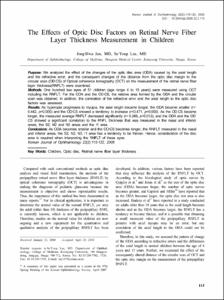The Effects of Optic Disc Factors on Retinal Nerve Fiber Layer Thickness Measurement in Children
- Keimyung Author(s)
- Jun, Jong Hwa; Lee, Se Youp
- Department
- Dept. of Ophthalmology (안과학)
- Journal Title
- Korean Journal of Ophthalmology
- Issued Date
- 2008
- Volume
- 22
- Issue
- 2
- Abstract
- Purpose: We analyzed the effect of the changes of the optic disc area (ODA) caused by the axial length and the refractive error, and the consequent changes of the distance from the optic disc margin to the circular scan (OD‐CS) of Optical coherence tomography (OCT) on the measurement of the retinal nerve fiber layer thickness(RNFLT) were examined. Methods: One hundred two eyes of 51 children (age range 4 to 15 years) were measured using OCT including the RNFLT. For the ODA and the OD‐CS, the relative area formed by the ODA and the circular
scan was obtained. In addition, the correlation of the refractive error and the axial length to the optic disc factors was assessed. Results: As hyperopia progresses to myopia, the axial length became longer, the ODA became smaller (r=‐ 0.442, p=0.000) and the OD‐CS showed a tendency to increase (r=0.471, p=0.000). As the OD‐CS became longer, the measured average RNFLT decreased significantly (r=‐0.248, p=0.012), and the ODA and the ODCS showed a significant correlation to the RNFL thickness that was measured in the nasal and inferior areas, the S2, N2 and N3 areas and the I1 area. Conclusions: As ODA becomes smaller and the OD‐CS becomes longer, the RNFLT measured in the nasal
and inferior areas, the S2, N2, N3, I1 area has a tendency to be thinner. Hence, consideration of the disc area is required when interpreting the RNFLT of these eyes.
- Publisher
- School of Medicine
- Citation
- Jong‐Hwa Jun and Se‐Youp Lee. (2008). The Effects of Optic Disc Factors on Retinal Nerve Fiber Layer Thickness Measurement in Children. Korean Journal of Ophthalmology, 22(2), 115–122. doi: 10.3341/kjo.2008.22.2.115
- Type
- Article
- ISSN
- 1011-8942
- Appears in Collections:
- 1. School of Medicine (의과대학) > Dept. of Ophthalmology (안과학)
- 파일 목록
-
-
Download
 oak-aaa-03473.pdf
기타 데이터 / 1.06 MB / Adobe PDF
oak-aaa-03473.pdf
기타 데이터 / 1.06 MB / Adobe PDF
-
Items in Repository are protected by copyright, with all rights reserved, unless otherwise indicated.